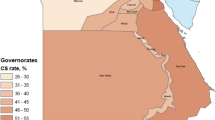Abstract
Purpose
Most women with one previous cesarean section (CS) are suitable for either a vaginal birth after CS (VBAC) or an elective repeat CS. Previously, nurse-led prenatal education and support groups have failed to have an impact on the mode of delivery, which women opted for after one CS. A novel one-stop obstetrician-led cesarean education and antenatal sessions (OCEANS) has been developed to inform and empower women in their decision-making following one previous CS. The objective of our study was to evaluate how OCEANS influences the mode of delivery for women who have previously had one CS.
Study Design
Two-hundred and sixty-six women who had a single previous lower segment CS were invited to attend OCEANS, which is a 1-h discussion group of women between 5 and 15 in number, facilitated by an experienced obstetrician. Data were collected prospectively on women who were invited to attend OCEANS over a 12-month period commencing on the 1st January 2012.
Results
188 (71 %) attended the group, while 20 (8 %) canceled their appointment and 58 (22 %) did not keep their appointment. Those who attended OCEANS were 38 % more likely to opt for a VBAC than those who did not attend. There was no difference in the rates of successful vaginal delivery between women who attended OCEANS and those who did not (56 vs. 61 %, p = 0.55).
Conclusions
While nurse-led prenatal education and support groups have no impact on mode of delivery after one CS, a dedicated obstetrician-led clinic increases the rate of those opting for VBAC by 38 %. Such clinics may be a useful tool helping in empowering women in their decision-making and reduce the rate of CSs.
Similar content being viewed by others
References
Paterok EM, Roenthal H, Sabel M. Nipple discharge and abnormal galactogram. Results of a long-term study (1964–1999). Eur J Obstet Gynecol Reprod Biol. 1993;50:227–34.
Guise JM, Eden K, Emeis C, et al. Vaginal birth after cesarean: new insights. Evid Rep Technol Assess. 2010;191:1–397.
National Institute for Health and Clinical Excellence. cesarean Section. NICE clinical guideline 132; 2011.
Royal College of Obstetricians and Gynaecologists. Birth after previous cesarean birth. RCOG Guideline No. 45. London: RCOG Press; 2007.
Silver RM, Landon MB, Rouse DJ, et al. Maternal morbidity associated with multiple repeat cesarean deliveries. Obstet Gynecol. 2006;107(6):1226–32.
Wu S, Kocherginsky M, Hibbard JU. Abnormal placentation: twenty-year analysis. Am J Obstet Gynecol. 2005;192(5):1458–61.
Thomas J, Paranjothy S. Royal College of Obstetricians and Gynaecologists Clinical Effectiveness Support Unit. The National Sentinel Supplementary Material (scanned copies of 1st pages of references) cesarean Section Audit Report. London: RCOG Press; 2001.
Landon MB. Vaginal birth after cesarean delivery. Clin Perinatol. 2008;35(3):491–504.
Emmett CL, Shaw AR, Montgomery AA, et al. Women’s experience of decision making about mode of delivery after a previous cesarean section: the role of health professionals and information about health risks. BJOG. 2006;113(12):1438–45.
Fraser W, Maunsell E, Hodnett E, et al. Randomized controlled trial of a prenatal vaginal birth after cesarean section education and support program. Childbirth Alternatives Post-Cesarean Study Group. Am J Obstet Gynecol. 1997;176(2):419–25.
Silver B, Zaman IF, Ashraf K, et al. A randomized trial of decision-making in asymptomatic carotid stenosis. Neurology. 2012;78(5):315–21.
Montgomery AA, Emmett CL, Fahey T, et al. Two decision aids for mode of delivery among women with previous cesarean section: randomised controlled trial. BMJ. 2007;334(7607):1305.
Ethical Standards
The manuscript does not contain clinical studies or patient data.
Conflict of interest
The authors declare that they have no conflict of interest.
Author information
Authors and Affiliations
Corresponding author
Rights and permissions
About this article
Cite this article
Wong, K.W., Thomas, J.M. & Andrews, V. Are Women’s and Obstetricians, Views on Mode of Delivery Following a Previous Cesarean Section Really OCEANS Apart?. J Obstet Gynecol India 64, 400–402 (2014). https://doi.org/10.1007/s13224-014-0553-0
Received:
Accepted:
Published:
Issue Date:
DOI: https://doi.org/10.1007/s13224-014-0553-0




